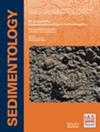Zagros山Kazhdumi浅层碳酸盐岩占主导的陆架内盆地Aptian海洋缺氧事件1a
IF 2.8
2区 地球科学
Q1 GEOLOGY
引用次数: 3
摘要
早阿普tian Selli海洋缺氧事件1a(约120 Ma)是中生代生物、气候、环境和地球化学扰动的主要事件,与有机质的广泛埋藏有关。基于新的沉积学、生物地层学和碳同位素数据,本研究追踪了沿阿拉伯板块东北缘的海洋缺氧事件1a相关扰动。研究的层序有5个完整的三级层序,具有3种相组合:(1)深开阔海相和陆架内盆地;(ii)浅海开阔中坡道;(三)内坡道。海洋缺氧事件1a‐等效沉积物包括前两个相组合(i)和(ii),厚度为25至31 m,对应于基于事件持续时间1.0至1.3 Myr的累积速率约1.9至3.1 cm kyr−1(未校正压实)。这段时间保留了碳同位素和海平面波动的高分辨率记录,从而实现了阿拉伯板块和特提斯之间的相关性。海洋缺氧事件1a的发生以生物变化为标志,从以牡蛎为主的浅海石灰岩(含丰富的有孔虫(Palorbitolina lenticularis和Choffatella decipiens))到深灰色的深水浮游有孔虫和富含放射虫的石灰岩(含燧石和富含有机质的页岩)。1a的上层海洋缺氧事件部分的特征是浅水-向上,后退相,标志着浅水-开阔海环境的回归,尽管没有恢复Palorbitolina-Choffatella组合。早阿普tian晚期的海洋缺氧事件1a恢复早期恢复了深海开放海相沉积(Kazhdumi舌)。富含Mesorbitolina的石灰岩的浅海开放环境的回归标志着阿普梯晚期的开始,随后是海平面的大幅下降和岩溶作用。本研究解决了在海洋缺氧事件1a期间影响整个阿拉伯板块东部环境扰动的事件顺序和时间的一些不确定性,并强调了浅层碳酸盐主导的大陆架内盆地作为全球海洋扰动期间碳同位素、海平面振荡和古环境变化的忠实记录者的重要性。本文章由计算机程序翻译,如有差异,请以英文原文为准。
Aptian Oceanic Anoxic Event 1a in the shallow, carbonate‐dominated intrashelf Kazhdumi Basin, Zagros Mountains
The early Aptian Selli Oceanic Anoxic Event 1a (ca 120 Ma) is a major Mesozoic episode of biotic, climatic, environmental and geochemical perturbations associated with the extensive burial of organic matter. Based on the new sedimentological, biostratigraphic and carbon‐isotope data from the Kazhdumi Intrashelf Basin, this study tracks the Oceanic Anoxic Event 1a‐associated perturbations along the north‐eastern margin of the Arabian Plate. The studied succession has five complete third‐order sequences with three facies associations: (i) deep open‐marine and intrashelf basin; (ii) shallow open‐marine mid‐ramp; and (iii) inner ramp. The Oceanic Anoxic Event 1a‐equivalent deposits include the former two facies associations – (i) and (ii) – and are 25 to 31 m thick, which corresponds to the accumulation rates of ca 1.9 to 3.1 cm kyr−1 (uncorrected for compaction) based on the 1.0 to 1.3 Myr duration of the event. The interval retained a high‐resolution record of carbon‐isotope and sea‐level fluctuations, which enables correlation across the Arabian Plate and Tethys. The Oceanic Anoxic Event 1a onset is marked by a biotic change from ostreid‐dominated shallow‐marine limestone with abundant foraminifera (Palorbitolina lenticularis and Choffatella decipiens) to dark grey deep‐water planktonic foraminifera‐rich and radiolaria‐rich limestone with chert and organic‐rich shale (Radiolarian Flood Zone). The upper oceanic anoxic event part of 1a is characterized by the shallowing‐upward, backstepping facies marking the return to a shallow open‐marine setting, albeit without recovery of the Palorbitolina–Choffatella association. Deep open‐marine deposition (Kazhdumi Tongue) was restored early during the Oceanic Anoxic Event 1a recovery in the latest early Aptian. A return to shallow open‐marine environments with Mesorbitolina‐rich limestone marks the beginning of the late Aptian, followed by a major sea‐level fall and karstification. This study resolves some of the uncertainties related to the order and timing of the events influencing the environmental disturbances across the eastern Arabian Plate during Oceanic Anoxic Event 1a and stresses the importance of shallow carbonate‐dominated intrashelf basins as faithful recorders of carbon‐isotope and sea‐level oscillations and palaeoenvironmental changes during global oceanic perturbations.
求助全文
通过发布文献求助,成功后即可免费获取论文全文。
去求助
来源期刊

Sedimentology
地学-地质学
CiteScore
8.20
自引率
11.40%
发文量
94
审稿时长
6-12 weeks
期刊介绍:
The international leader in its field, Sedimentology publishes ground-breaking research from across the spectrum of sedimentology, sedimentary geology and sedimentary geochemistry.
Areas covered include: experimental and theoretical grain transport; sediment fluxes; modern and ancient sedimentary environments; sequence stratigraphy sediment-organism interaction; palaeosoils; diagenesis; stable isotope geochemistry; environmental sedimentology
 求助内容:
求助内容: 应助结果提醒方式:
应助结果提醒方式:


